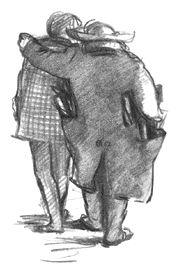Vie de Boheme

(5 of 24)
How the Bohemian Club was Founded
Employing the dreadful nasal organ that was peculiar to him, he returned to the judicial murder of his ballad. Then, evidently satisfied with the result, he expressed his self-congratulation with the joyful grimace that always straddled his nose, like a
circumflex accent, whenever he was pleased with himself.
This self-complacent bliss, however, was of short duration. The neighbouring clock-tower struck eleven. Each stroke entered the room and lost itself in mocking noises that seemed to ask the unfortunate Schaunard: “Are you ready?”
The artist bounced up and down as he sat. “Time is running like a deer,” he said. “I’ve only three-quarters of an hour in which to find my seventy-five francs, and a new lodging. I’ll never do it in time – that would be to encroach too much on the realm of magic. Well, I’ll give myself five minutes to find a way.” Putting his head between his knees, he descended into the depths of meditation.
The five minutes elapsed, and Schaunard raised his head again, without having found anything that looked like seventy-five francs.
“There’s only one thing I can do to get out of here – and that is to walk out quite naturally. The weather is fine; my good friend Fortune is perhaps taking a stroll in the sunshine. She will certainly have to offer me hospitality until I have found the means of settling up with M. Bernard.”
Schaunard stuffed the cavernous pockets of his greatcoat with all that they could hold, tied up some underwear in a scarf, and, after a few touching words of farewell to his domicile, went out.
As he was crossing the courtyard, he was stopped by the janitor, who seemed to have been lying in wait for him. “Ah, M. Schaunard,” he said, barring the artist’s passage, “don’t you remember? Today’s the eighth.”
Eight and eight, put six,
Six and carry one …
Schaunard hummed. “I remember nothing else!”
To be continued …
[Vie de Bohème by Henry Mürger, a vivid portrait of the ‘Bohemian’ life of the artistic quarter of
Leave a Response
You must be logged in to post a comment.

